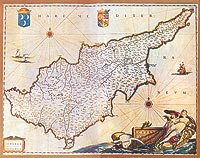
North Cyprus History.
 |
the north cyprus travel guide |
 |
|
North Cyprus History
The island of Cyprus has a long and varied history, ever since the first settlers came to the island in around 8500B.C. The abundance of copper and timber on the island, combined with its position in the middle of the major trading routes made Cyprus irresistible to a whole range of foreign powers, including the Phoenicians, Assyrians, Persians, Egyptians, Greeks and Ottomans. RomansCyprus was annexed to Rome in 58B.C. and by 43A.D. the island had become Christian, as rare mosaic floors in the ancient ruins of the city of Soli, North Cyprus, show. In 330 A.D. Cyprus became part of the Byzantine Empire. ByzantineThe Byzantine influence can be seen everywhere in North Cyprus, from the original castle structure at Kyrenia through to the Five Finger Mountains. These were named after the Byzantine hero Dighenis, who allegedly leapt from Asia Minor to Cyprus, leaving his fingermarks as the mountains. BritishIn 1191 Richard the Lionheart conquered Cyprus whilst on his way to the Holy Land on a Crusade, and then sold it to the Knights Templar, who promptly gave it back and Richard sold it again, this time to a French noble, Guy de Lusignan. The Lusignan family ruled the island with an iron fist for the next three hundred years, despite a brief invasion by the Genoese in 1372 and another by the Marmelukes in 1426. VenetianWhen the last Lusignan king died in 1489, his wife gave the island to Venice. The Venetians fortified the island, using it as a military base, and taxed the citizens heavily. It was somewhat of a relief to the Cypriot people when the Ottomans threw out the Venetians in 1571. OttomanThe Ottomans instated the Orthodox Church and outlawed the Catholic faith, and allowed Islam to flourish too. The Empire successfully ruled the island for almost five hundred years. By 1878, Britain had joined forces with the Ottoman Empire to keep the Russian threat at bay, and Cyprus became subject to British government and legal systems. Cyprus in two World WarsWhen Turkey sided with Germany in World War I, it ended the war a defeated nation, and Cyprus became a British Crown colony in 1925. After World War II, the movement by Greek Cypriots for union with Greece gained momentum, with rioting and violence aimed at the British rulers. In 1957, the UN adopted a resolution to establish and independent Cyprus, and this was ratified in 1960 by the Treaty of Zurich. The Treaty, signed by Britain, Greece and Turkey, also protected the rights of Turkish Cypriots. Divided North CyprusUnfortunately the treaty did not last, and civil war broke out in 1963. The UN sent in troops and established the Green Line to try and keep the peace. Matters came to a head in 1974 when the Greek National Guard launched a coup against then President Makarios, to promote unity with Greece (known as Enosis). Turkey promptly intervened to protect the interests of Turkish Cypriots, as the terms of the Treaty of Zurich permitted. Turkish Republic of Northern CyprusThe Turkish republic of Northern Cyprus was established in 1983, but has not achieved full international recognition. In 2002, intense dialogue between north and south helped ease the tension, so that in 2003, Northern Cyprus border crossings with the south opened up, under more relaxed border entry rules. In 2004, twin referendums were held on united the island according to the UN Annan Plan. Sadly, although this plan was accepted by Turkish Cypriots, it was rejected by Greek Cypriots, and the island remains divided at the time of writing. The Republic of Cyprus (south Cyprus) joined the EU in 2004. |
|
North Cyprus quick: holidays | flights | hotels | property | kyrenia | famagusta | photos | map | weather | history | news
All text is copyrighted by Cyprus44. Photographs are copyrighted by their respective photographers.
For more information read our copyright policy, privacy policy and disclaimer.
This web page is served on 20 April 2025 at 11:36:30 AM.
![]()
Cyprus44 in other languages: Nordzypern | Chypre Nord | Severní Kypr | Северный Кипр
partner sites: goNorthCyprus Travel | Pacific Rent-A-Car | Amy Holiday Villas | other partner sites








